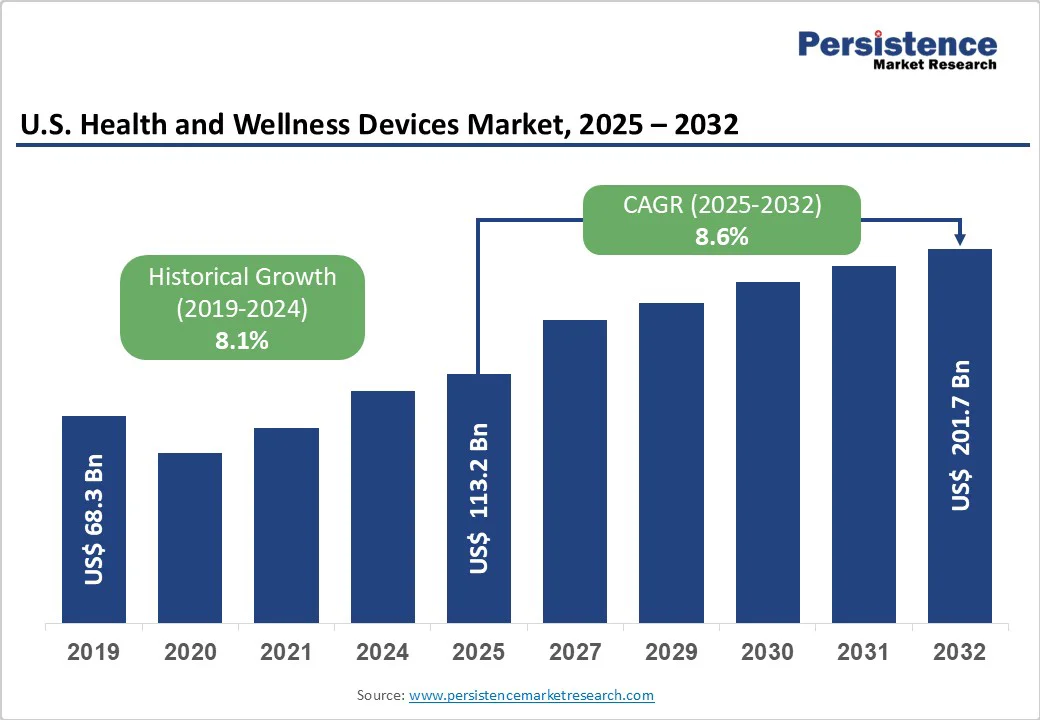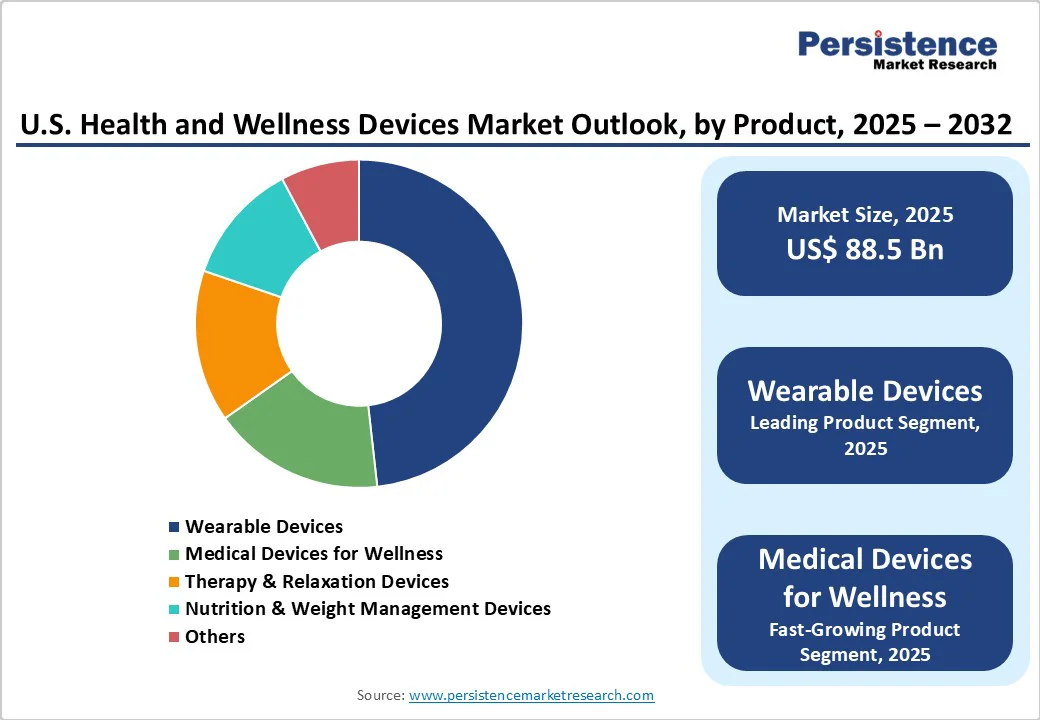ID: PMRREP35777| 190 Pages | 27 Oct 2025 | Format: PDF, Excel, PPT* | Healthcare

The U.S. health and wellness devices market is expected to reach US$113.2 billion in 2025. It is expected to reach US$201.7 billion by 2032, growing at a CAGR of 8.6% during the forecast period from 2025 to 2032, driven by the increasing prevalence of chronic diseases, rising consumer health awareness, and technological advancements in wearables and connected health solutions.
According to the CDC, chronic diseases cause 71% of all U.S. deaths and drive most of the US$4.5 trillion in annual healthcare costs. Rising demand for preventive care, along with FDA support for wellness products and digital health innovations, is fueling strong market growth across all device categories.
| Key Insights | Details |
|---|---|
| U.S. Health and Wellness Devices Market Size (2025E) | US$113.2 Bn |
| Market Value Forecast (2032F) | US$201.7 Bn |
| Projected Growth (CAGR 2025 to 2032) | 8.6% |
| Historical Market Growth (CAGR 2019 to 2024) | 8.1% |

The U.S. health and wellness devices market is driven by strong healthcare reforms, technology integration, and shifting consumer lifestyles. The Affordable Care Act and private insurance reimbursement policies that cover up to 70% of continuous glucose monitor (CGM) costs have significantly boosted adoption among hospitals and clinics, particularly for chronic disease management.
The surge in telehealth adoption, accounting for nearly 30% of healthcare visits in 2025, has further accelerated demand for wearable devices and wellness platforms. These devices, when integrated with virtual care services such as Teladoc, support continuous health tracking and remote management of conditions like diabetes, hypertension, and mental health. Rising awareness of preventive healthcare and the emphasis on fitness and active living are additional market catalysts.
The growing number of sports and fitness centers, over 25,000 gyms across the U.S., is fueling demand for nutrition and weight management tools, including smart scales and body composition monitors from brands like Withings. Together, digital health advancements, government support, and consumer-driven wellness trends are reinforcing the U.S.’s leadership in connected health and personalized wellness solutions.
The U.S. health and wellness devices market faces key restraints, including high device costs and growing concerns about data privacy. Advanced wearable and medical devices, while technologically sophisticated, remain expensive, limiting accessibility for many consumers.
Consumer-grade devices such as fitness trackers and smartwatches are priced between US$200 and US$800, whereas clinical-grade monitoring equipment, including continuous glucose monitors and blood pressure monitors, can range from US$1,000 to US$5,000. This premium pricing creates a significant barrier, particularly for lower-income demographics, slowing mass adoption.
In addition, data privacy and security concerns pose another challenge. With increasing reliance on connected devices and digital health platforms, sensitive personal health information is at risk. IBM reports that 60% of healthcare organizations have experienced data breaches in the past two years.
Compliance with HIPAA and state privacy regulations adds further operational complexity and costs for manufacturers, potentially hindering innovation and discouraging smaller companies from entering the market. Together, these factors may slow overall market growth.
The rapid adoption of telehealth in the U.S., accelerated by the COVID-19 pandemic, has created significant opportunities to integrate health and wellness devices. According to the CDC, telehealth visits surged by 154% in March 2020, prompting healthcare systems to expand their remote monitoring capabilities to ensure continuity of care. This trend has driven increased demand for wearable devices, connected health sensors, and mobile health platforms that enable real-time monitoring of vital signs, chronic conditions, and overall wellness from home.
Government support has further strengthened the market opportunity. The Centers for Medicare & Medicaid Services (CMS) has expanded coverage and reimbursement policies for remote patient monitoring services, enabling patients to use connected devices, such as continuous glucose monitors, blood pressure monitors, and pulse oximeters, for chronic disease management.
The growing elderly population in the U.S. is projected to rise from 58 million in 2022 to 82 million by 2050, according to the Population Reference Bureau, representing a substantial target segment for aging-in-place technologies and remote health monitoring solutions. These factors collectively create a favorable environment for market growth and innovation in the U.S. health and wellness device sector.
Wearable devices are anticipated to hold the largest share of the U.S. health and wellness devices market in 2025, accounting for over 49% of total revenue. The dominance of wearables is fueled by their versatility, affordability, and growing consumer inclination toward self-monitoring and preventive healthcare.
Popular devices such as smartwatches and fitness trackers from brands like Fitbit, Apple, and Garmin Ltd. have become integral to daily wellness routines. These products offer advanced features, including heart rate monitoring, calorie tracking, sleep pattern analysis, and stress management insights. The growing adoption of digital health ecosystems and seamless integration with smartphone apps has further enhanced user engagement.
Increased corporate wellness programs and health insurance incentives for activity tracking have boosted sales. Meanwhile, medical-grade wearable devices are seeing rising use in remote patient monitoring programs, especially for chronic disease management and post-hospital care, reflecting the U.S. market’s strong shift toward connected, data-driven wellness solutions.
Chronic disease management leads the U.S. health and wellness devices market in 2025, capturing nearly 37% of the market. The segment’s dominance is driven by the rising prevalence of diabetes, cardiovascular disorders, and hypertension, which are fueling strong demand for continuous glucose monitors (CGMs), heart rate monitors, and pulse oximeters.
In the U.S., the growing adoption of CGMs among diabetic patients, supported by FDA approvals for advanced systems like DexCom G7 and Abbott’s FreeStyle Libre has significantly expanded access. Reimbursement policies by Medicare and private insurers for remote patient monitoring further enhance affordability and usage in clinical and home-care settings.
Increasing awareness of preventive health management and the expansion of telehealth platforms have also boosted device adoption. Meanwhile, the mental health and stress relief segment is rapidly expanding, driven by growing anxiety and stress levels among the U.S. workforce and students, leading to increased uptake of neurofeedback and relaxation-focused wearables.

The U.S. health and wellness devices market exhibits moderate consolidation with established technology companies and medical device manufacturers competing across different segments. Major players, including Apple, Samsung, Abbott, and Medtronic, leverage extensive R&D capabilities and strong distribution networks to maintain competitive advantages. Market leaders focus on product innovation, clinical validation, and regulatory compliance to differentiate their offerings.
Companies increasingly pursue strategic partnerships with healthcare providers, insurance companies, and digital health platforms to expand market reach and enhance value propositions. FDA approval and clinical evidence play crucial roles in competitive positioning, particularly for medical-grade devices targeting chronic disease management applications.
The U.S. market is projected to be valued at US$113.2 Billion in 2025.
Key drivers in the U.S. health and wellness devices market include the rising prevalence of chronic diseases, technological advancements in wearable technology, and FDA regulatory support for digital health innovations.
The U.S. health and wellness devices market is poised to witness a CAGR of 8.6% between 2025 and 2032.
Rising demand for early disease detection, expansion of ambulatory surgical centers, AI integration, personalized vision care, and strategic partnerships offer significant growth opportunities in the U.S. market.
Major players in the U.S. health and wellness devices market include OMRON Corporation, Fitbit, Garmin Ltd., Medtronic, and Abbott.
| Report Attribute | Details |
|---|---|
| Historical Data/Actuals | 2019 - 2024 |
| Forecast Period | 2025 - 2032 |
| Market Analysis | Value: US$ Bn |
| U.S. Coverage |
|
| Segmental Coverage |
|
| Competitive Analysis |
|
| Report Highlights |
|
By Product
By Application
By End-user
By Zone
Delivery Timelines
For more information on this report and its delivery timelines please get in touch with our sales team.
About Author